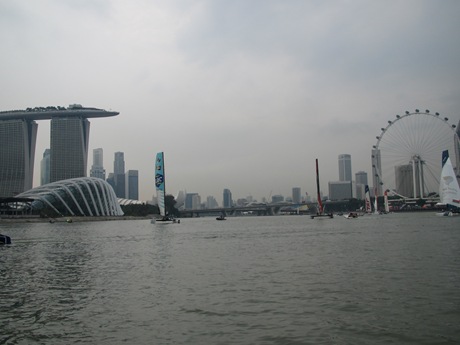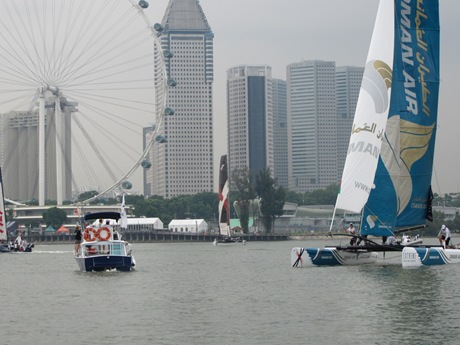With not much wind and very shifty as well, we did only four races today in the ESS in Singapore. The 10 Extreme Forties circled Marina Bay to find the wind and get trough the courses. With four umpire boats we can cover almost all incidents as boats are not moving that fast.
Today I was on the water with Charlie Carter who is filling in for the eight umpire position. Charlie is the Extreme Forty Class Manager. He’s employed by OC Third Pole who in turn is hired to manage the Class for Extreme Sailing Series SA, the company that has the design rights to the class. It is not a class that is formed by the sailors who have a class boat- like most classes. Although those are asked for input on a regular bases (twice a year there’s an open forum organized), this class is company owned. Charlie is one of four people who manages the X40-class.
Charlie Carter has an engineering background and he’s responsible for technical management of the class. He has extensive experience in the marine industry and has managed various projects in the past, like the Oman Trimaran project and the Imoca open 60 project.
He’s looking after the future of the X40, liaisons with the teams about development and is first in line to make sure the boat is truly a one-design class. He manages the technical support, servicing of the equipment and a supply train for parts for new and existing boats. If any boat gets damaged he can facilitate repairs for teams that don’t have the capability to do this themselves. By being at each class event he can keep in contact with all sailors and owners and provide direct support.
The Extreme 40 was first used in the In-Port Races for the Volvo Ocean Race in 2005. Of those first five boats build, four are still sailing the Extreme Sailing Series. But since then the fleet has increased and now stands at 20 boats.
The X40 is still a very competitive boat that can achieve fantastic acceleration and speeds. Combined with a relatively simple montage and de-montage (two persons can rig (or de-rig) a boat in a day) because of the use of basic parts, the boat offers a fantastic value for money. Only four – though very hard working – crew are needed to sail this big cat, which leaves the fifth place for a guest. If you have 384.500 pound to spare, you can own a X40 kitted out with all parts, sails and even a container to put the complete boat into.
“How does he see the future development of the Class?” I asked Charlie in between races.
He answered: “More modular sections would be a good way to improve the speed in which a boat can be repaired. So sailing can be resumed very fast.
Instead of a composite repair, then only bolting-on an aft section would be needed to fix a sheered off transom – like Team New Zealand had in the previous edition.”
Charlie is also looking into a system to prevent inversion of the boat after a capsize. “The equivalent of 150 kg buoyancy at the top of the mast is needed to keep the boat from completely turning upside down” He hopes a system can be in place for next year – either by automatically inflation or a fixed buoyancy….
The ESS will be back next year – doing the full global circle with old and a couple of new venues. And Charlie will be there as well, count on it.



They need a huge fender tied to tyhe top of the mast.
ReplyDeleteWag
@Wag
ReplyDeleteWhat colour?
I think there is an opportunity for sponsorship here. Think of all the different synergies.
ReplyDeleteWag